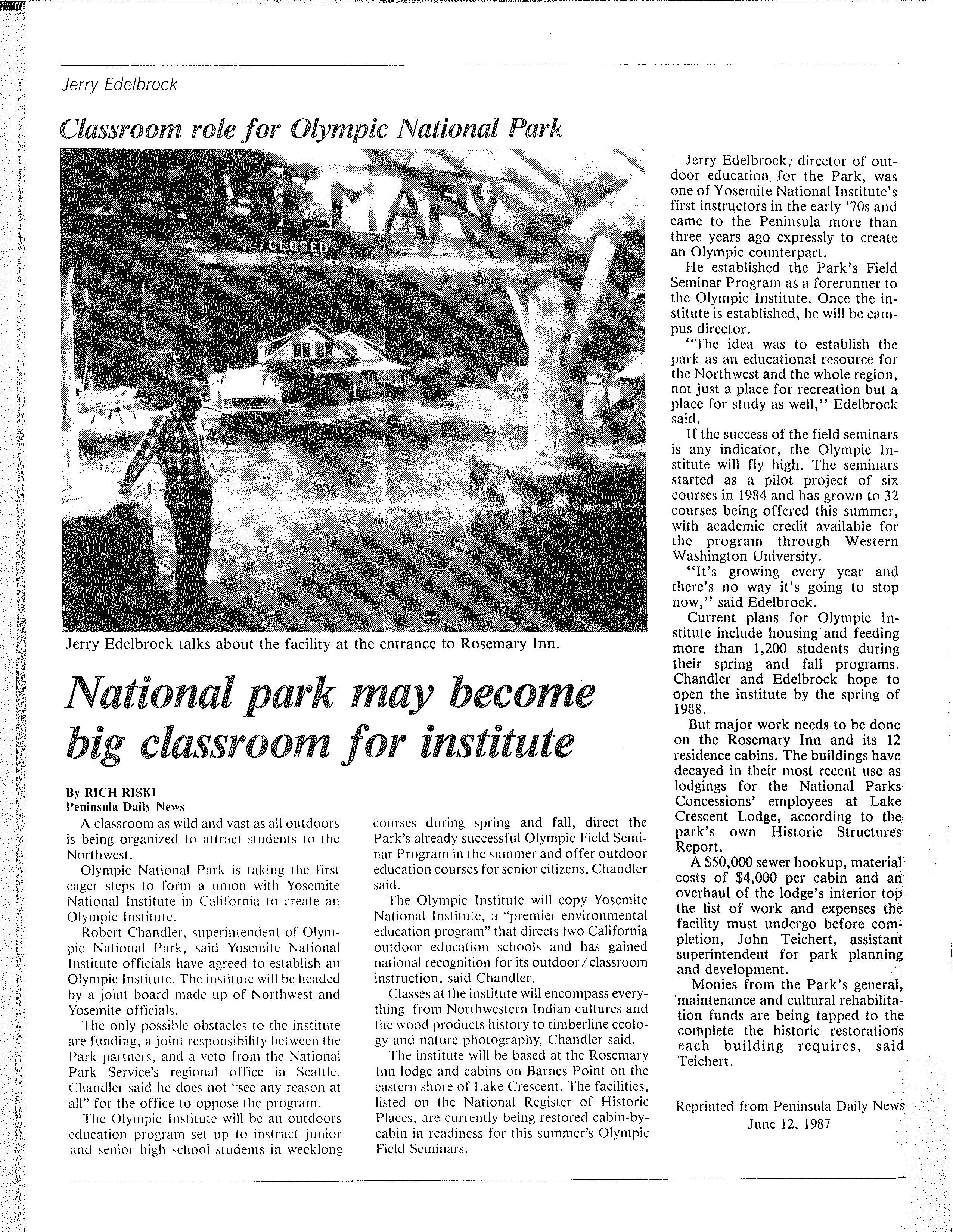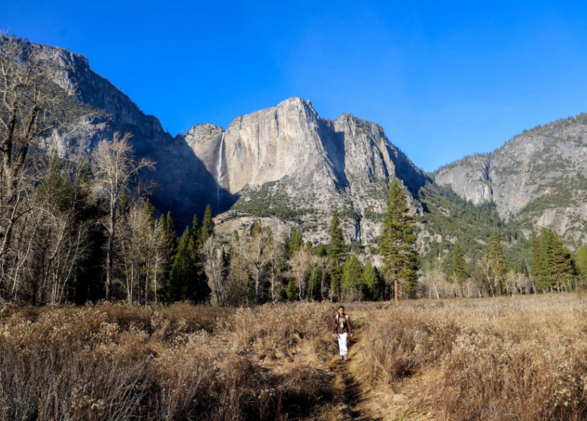Jerry Edelbrock and the Origins of Olympic

Jerry Edelbrock is a builder: a builder of partnerships, a builder of people and a builder of visions. In 1983, long before the notion of a Yosemite Institute (YI) in Olympic National Park at the Rosemary Inn had come to fruition, Jerry was building the foundation for what was to come.
Jerry had graduated from University of California Santa Barbara with a degree in ecology and systemic biology and found himself teaching outdoor education at Cachuma Lake in Santa Barbara. He immediately fell in love with teaching kids in the outdoors. During those years, Jerry took a trip to Yosemite National Park and heard from a friend about Yosemite Institute, which was just getting started at the time. Jerry jumped on board and was one of the very first educators at the campus. He temporarily left the valley to get his graduate degree but returned to YI where he was program coordinator for a time.
After several years of success in Yosemite, there were murmurings of opening a campus in the Pacific Northwest. Jerry once again left the valley and headed north with the group of YI representatives invited to explore various sites in the area. As good friend and comrade Walter Sive writes in a reflection of the times, “Bob Chandler, Superintendent of Olympic National Park, had long hoped for a strong educational program in the park.”
Upon touring several sites and meeting with various figures in the community, YI leaders decided it was too early in its existence to open a Pacific Northwest campus. Jerry, however, decided to stay in the Port Angeles area. It was summer of 1984 and he launched a program by the name of “Olympic Field Seminars,” a course for adults on everything from mycology to Olympic Peninsula native cultures.
It was during this time that a friendship between Walter and Jerry took root, as Walter was working as assistant manager at the Lake Crescent Lodge at the time and living in the historic Rosemary Inn cabins with the rest of the lodge staff.
Field Seminars continued through 1985-1987 and proved to be extremely popular. The Pacific Northwest National Park and Forest Association acted as an umbrella organization for the programs Jerry developed. During these years, Jerry and Superintendent Bob Chandler brainstormed where they might put in a fixed campus. There were forays to a County Camp (a Park inholding) and a site in the Elwha Valley. But Superintendent Chandler, Jerry and others finally landed on a plan to have the concessioner vacate the Rosemary employee housing site and have the Park provide land and other support for new employee housing. Superintendent Chandler’s leadership ensued that there were significant dollars appropriated for the rebuild of structures at Barnes Point.
By spring of 1987, the Concessioner had vacated Rosemary; the land then reverted to management by the Park Service. The Park immediately began improving the site and some of the historic cabins.
One could say that it was the Rosemary Inn that planted a seed, or perhaps watered a seed that was already planted, in Jerry’s head. “Sensing that the use of Rosemary for a permanent educational campus was imminent, Edelbrock creatively secured all sorts of used furniture, equipment and even whole buildings to later use on the campus,” said Walter.
There were a lot of fits and starts, but these guys were passionate about the mission. They were everything to everyone, resourceful and scrappy. It’s how Don Rees and everyone else got it started. It just kept on going and here we are.Walter Sive, NatureBridge Board of Directors and Chair of the Olympic Board
Over the next few months, Jerry would spend weekends rallying friends to help him scavenge warehouses for furniture while building relationships with folks in the National Park Service. One afternoon, Jerry borrowed a truck to go to the surplus property depot of the federal government in Tacoma, Washington, to obtain a lot of the furniture for the new campus.
“I grabbed everything I thought the campus would need to get it off the ground and stashed it all in a garage on Barnes Point until we could move into Rosemary.”
There was even a story about Jerry discovering an old cabin owned by the NPS. Since he was now friendly with them all, he inquired about its use, and it didn’t take long for them to sign it over to Jerry. The next Saturday morning, he got a crew to help him lift the building and move it to the Lake Crescent campus. It became his new office. Today, it serves as the microscope lab for NatureBridge students.
“There were a lot of fits and starts, but these guys were passionate about the mission. They were everything to everyone, resourceful and scrappy. It’s how Don Rees and everyone else got it started. It just kept on going and here we are,” Walter recently reflected. “I was cheerleading from the side. The only thing I did was champion new employee housing.” Walter today sits on the NatureBridge Board of Directors and serves as Chair of the Olympic Board.
By 1987, the Rosemary Inn was available. As Walter recalled, Jerry, along with the support of Bob, went back to the board of the Yosemite Institute with an ask to take over programming in the park. Staff from the NPS worked tirelessly for several months to restore the historic site and to ensure that lodging was up and running for the fall. Thanks hugely to that in-kind support from Bob and the NPS, YI signed a 20-year lease in October of 1987.

“The support from the park was substantial,” said Walter. “It is hard to overstate the enthusiasm so many showed for creating not only a superb setting for an environmental education campus, but also for the opportunity to restore the main Lodge at Rosemary and its outlying cabins… many of [the staff] remarking that this was some of the more satisfying work they had ever done in the park.”
One of the final touches that Jerry put on the Olympic campus was an item he received from his grandfather. As the team got ready to open the campus, they realized that they did not have a way to call students to mealtimes. As timing would have it, he recovered a large bell in the family that was about to be thrown away. Naturally, it was hung at the Inn. It’s the same bell that’s still there today.
Throughout his time building connections, infrastructure, and programming in Olympic, Jerry always went back to one question: “Is it in the best interest of the park?” One could argue that this is what made Jerry and the early years of NatureBridge (then YI) at Olympic park so successful. He eventually moved on from educating, though the mission of connecting kids to the outdoors never left him. Years later, Jerry recounts still running into former students who remember him as the “mushroom man from Yosemite!” or, “the best educator they ever had.” Today, Jerry is Vice President and COO of Yosemite Conservancy.

